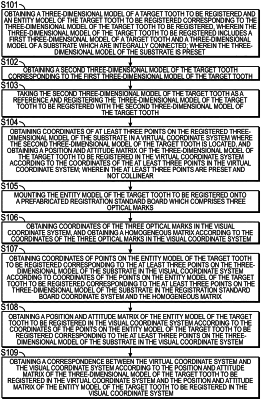| CPC A61C 9/004 (2013.01) [A61B 34/10 (2016.02); A61C 8/00 (2013.01); A61C 13/34 (2013.01); G06T 19/003 (2013.01); G06T 19/20 (2013.01); A61B 2034/105 (2016.02); A61B 34/30 (2016.02); G06T 2210/41 (2013.01); G06T 2219/2004 (2013.01)] | 10 Claims |

|
1. A method for performing visual navigation assisted dental implant surgery, the method comprising, by a computing device:
obtaining a baseline 3D model of a target tooth to be registered, wherein the baseline 3D model includes (1) a first 3D model of an entity model of the target tooth, and a (2) 3D model of a substrate to which the entity model is attached, wherein the 3D model of the substrate is preset;
performing a live scan of the target tooth to obtain a second 3D model that corresponds to the first 3D model;
utilizing the second 3D model as a reference to register the baseline 3D model with the second 3D model;
obtaining coordinates of at least three points on the 3D model of the substrate in a virtual coordinate system in which the second 3D model is located, and obtaining a position and attitude matrix of the baseline 3D model in the virtual coordinate system according to the coordinates of the at least three points in the virtual coordinate system, wherein the at least three points are preset and not collinear;
obtaining, by imaging a prefabricated registration standard board that comprises three optical marks, and onto which the entity model is mounted, coordinates of the three optical marks in a visual coordinate system, and obtaining a homogeneous matrix according to the coordinates of the three optical marks in the visual coordinate system;
obtaining coordinates of points on the entity model corresponding to the at least three points on the 3D model of the substrate in the visual coordinate system according to coordinates of the points on the entity model corresponding to the at least three points on the 3D model of the substrate in the prefabricated registration standard board and the homogeneous matrix;
obtaining a position and attitude matrix of the entity model in the visual coordinate system according to the coordinates of the points on the entity model corresponding to the at least three points on the 3D model of the substrate in the visual coordinate system;
obtaining a correspondence between the virtual coordinate system and the visual coordinate system according to the position and attitude matrix of the baseline 3D model in the virtual coordinate system and the position and attitude matrix of the entity model in the visual coordinate system; and
providing the correspondence to a navigation device to enable robot-assisted dental implant surgery to be performed on the target tooth.
|